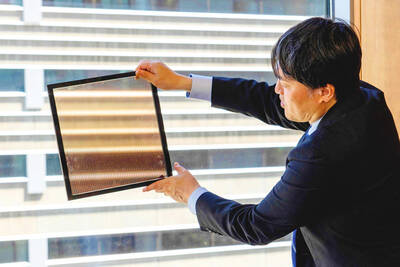The Port of Taipei will inaugurate two container piers today, which will upgrade the port in Tamsui, Taipei County, to the second largest international seaport in the country behind Kaohsiung Harbor.
The two container piers were among seven that were scheduled to be built by 2014 under an 11-year build-operate-transfer (BOT) project developed i 2003 by the Ministry of Transportation and Communications (MOTC) with the cooperation of three local maritime companies.
By 2014, when all seven container piers at the Port of Taipei are operational, the annual container handling capacity of the port is expected to reach 4 million TEUs (20-foot equivalent units), MOTC officials said.
The Port of Taipei, a seaport built on reclaimed land, lies south of the Tamsui River (淡水河) estuary in northern Taiwan and faces west. It covers more than 3,100 hectares of marine area, almost five times the size of Keelung Harbor, which is 63km east of Tamsui. The Port of Taipei was designed to be an auxiliary port of Keelung Harbor, which handles only coastal shipping operations because of its limited capacity.
However, it is now positioned to become a major seaport that can handle deep sea shipping operations and direct cross-strait shipping services that were launched on Dec. 15.
Under the BOT development project, Evergreen Marine Corp (長榮海運), Yangming Marine Transport Corp (陽明海運) and Wan Hai Lines Ltd (萬海航運) will jointly invest NT$20.32 billion (US$584 million) to build the seven-pier container port over an 11-year period.
The other five container piers in the project will be built over the next five years at a rate of one per year, the MOTC said.
Most of the containers bound for overseas ports are usually transported by road from northern or central Taiwan to Kaohsiung Harbor then loaded onto ocean-going vessels. Containers from abroad, particularly from Western countries, are shipped to Kaohsiung Harbor then transported by road to their destinations inland.
The development of the Port of Taipei container piers will help save exporters and importers road transport time and costs, as containers for international shipping can now be handled at the Taipei port, ministry officials said.

UNCERTAINTIES: Exports surged 34.1% and private investment grew 7.03% to outpace expectations in the first half, although US tariffs could stall momentum The Chung-Hua Institution for Economic Research (CIER, 中華經濟研究院) yesterday raised its GDP growth forecast to 3.05 percent this year on a robust first-half performance, but warned that US tariff threats and external uncertainty could stall momentum in the second half of the year. “The first half proved exceptionally strong, allowing room for optimism,” CIER president Lien Hsien-ming (連賢明) said. “But the growth momentum may slow moving forward due to US tariffs.” The tariff threat poses definite downside risks, although the scale of the impact remains unclear given the unpredictability of US President Donald Trump’s policies, Lien said. Despite the headwinds, Taiwan is likely

When Lika Megreladze was a child, life in her native western Georgian region of Guria revolved around tea. Her mother worked for decades as a scientist at the Soviet Union’s Institute of Tea and Subtropical Crops in the village of Anaseuli, Georgia, perfecting cultivation methods for a Georgian tea industry that supplied the bulk of the vast communist state’s brews. “When I was a child, this was only my mum’s workplace. Only later I realized that it was something big,” she said. Now, the institute lies abandoned. Yellowed papers are strewn around its decaying corridors, and a statue of Soviet founder Vladimir Lenin

UNIFYING OPPOSITION: Numerous companies have registered complaints over the potential levies, bringing together rival automakers in voicing their reservations US President Donald Trump is readying plans for industry-specific tariffs to kick in alongside his country-by-country duties in two weeks, ramping up his push to reshape the US’ standing in the global trading system by penalizing purchases from abroad. Administration officials could release details of Trump’s planned 50 percent duty on copper in the days before they are set to take effect on Friday next week, a person familiar with the matter said. That is the same date Trump’s “reciprocal” levies on products from more than 100 nations are slated to begin. Trump on Tuesday said that he is likely to impose tariffs

Japan is heavily investing in a new kind of ultra-thin, flexible solar panel that it hopes will help it meet renewable energy goals while challenging China’s dominance of the sector. Pliable perovskite panels are perfect for mountainous Japan, with its shortage of flat plots for traditional solar farms. A key component of the panels is iodine, something Japan produces more of than any country but Chile. The push faces some obstacles: Perovskite panels contain toxic lead, and, for now, produce less power and have shorter lifespans than their silicon counterparts. Still, with a goal of net zero by 2050 and a desire to